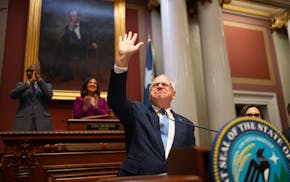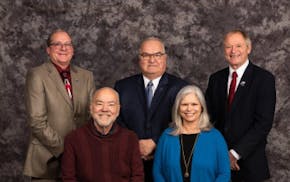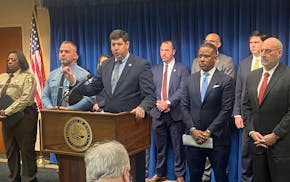Editor's note Jan. 14: On Jan. 13, the National Student Clearinghouse Research Center released new information about a "methodological error" in its data on freshmen enrollment, which actually increased last fall, not decreased as its preliminary report stated. See our full story.
Across Minnesota, college officials are celebrating increases this year in undergraduate enrollment after years of declines.
But new national data paints a different — and some say, concerning — picture: In 2024, fewer Minnesota 18-year-olds enrolled in college here or in other states.
The new data, published this month by the National Student Clearinghouse Research Center, shows that, while undergraduate enrollment is rising nationally and in Minnesota, 12% fewer 18-year-olds from Minnesota enrolled in college in the fall compared to last year — among the country's biggest drops. Nationally, the figure is about half that.
"Definitely it should be something of a concern, right?" said Hee Sun Kim, senior research associate at the Virginia-based organization. "Not just for particular states only, but overall."
In Minnesota, several higher education officials weren't alarmed by the new numbers, with some saying that a drop was expected due to widespread financial aid application problems; others questioned the center's data.
Many touted the increases in overall enrollment that colleges and universities, which draw students from outside the state as well, are seeing this year. Overall undergraduate enrollment is up 8% at Minnesota State institutions, up about 3% in the University of Minnesota system, and up 2% among Minnesota Private College Council schools. Freshman enrollment is also up 12% for Minnesota State, 7% for the U system and 3% for private colleges.
The enrollment bumps are a welcome sign after many schools have weathered steady declines for more than a decade, largely the result of decreased birth rates years ago.
"We are really excited about where we are, enrollment-wise," said Paul Shepherd, associate vice chancellor for student affairs and enrollment management at Minnesota State. "I think it's a really great example of how strong partnerships between the leadership of the state and higher ed can make just a huge difference in increasing access to higher education."
School officials credited new scholarships and improved efforts to help students succeed during an exceptionally difficult year in higher education.
In the fall, the state started a successful new scholarship effort – the North Star Promise – just months after unexpected deficits in another state financial aid program left students and college administrators scrambling to make up lost funding.
Colleges and universities have also had to rapidly adjust to federal changes, including the Supreme Court striking down the use of affirmative action in college admissions and the chaotic, delayed roll-out of the new Free Application for Federal Student Aid (FAFSA). The COVID-19 pandemic also prompted fewer students to go to college in Minnesota through 2022, the latest year Office of Higher Education data was available.
"Having done this for 25 years, I can't think of a year where it's ... more complicated to understand the trends that we're seeing and to sort of make sense of what's driving students in any particular direction," said Wendy Robinson, the state Office of Higher Education's assistant commissioner for programs, policy, and grants.
Enrollment declines
Colleges across the country have been losing students since 2010 as tuition increased, demographics shifted and more Americans questioned the return-on-investment of a college degree. Wages have increased in jobs requiring fewer skills, prompting some young people to enter the job market right away.
The new data from the National Student Clearinghouse Research Center is the first time it has tracked 18-year-olds' college enrollment immediately after high school. Kim said any of the recent headwinds in higher education could have caused the declines. She added that the data is preliminary, and includes about 80% of U.S. institutions.
The center's data showed double-digit declines in the number of newly enrolled 18-year-old college students from Minnesota in the fall, despite a 5% jump in Minnesota's undergraduate enrollment overall. The lower numbers of 18-year-olds enrolling is a concern because students who don't enroll right after high school are less likely to ever go to college. A smaller high school graduating class last summer also could be a factor, she said.
How could Minnesota's overall undergraduate enrollment show gains, while those among 18-year-olds — which would include Minnesotans enrolled anywhere in the country — nosedive? She said growth is probably being led by strong undergraduate retention and older students returning after a "stop out," referring to temporary leaves from college before completing a degree.
Some officials were skeptical of the data.
Megan Rozowski, research and policy director for the Minnesota Private College Council, said the numbers were "not consistent with data we've seen" and noted positive first-year enrollment trends among schools.
Minnesota Office of Higher Education officials wondered what the cutoff was for a student turning 18 to be included in the data, along with whether Minnesota's high school students who took college courses would be counted as new freshmen.
"I have more questions than I have opinions about it at this point," Robinson said.
Carrie Schneider, the Office of Higher Education's research director, said the report appears to exclude some Minnesota graduating high school seniors. The agency wouldn't use the data to draw conclusions about fall enrollment trends among recent high school graduates, she said, noting that the Minnesota Department of Education hasn't yet released last summer's graduating class numbers.
Nathan Grawe, a Carleton College professor who wrote a book on how colleges can adapt to population changes, noted that a significant number of Minnesota's graduating seniors attend college in other states. "Did more Minnesota students stay home?" he said. "It would be great news if that were the case."
New efforts to draw, retain students
Colleges and universities across the state are trying new efforts to draw and retain students — from offering new scholarships to improving support services.
With fewer students going to college, many schools focus on recruiting elsewhere or among new groups, Grawe said. But that tactic doesn't work for every institution, he said, so many colleges are starting to focus on improving support services to boost retention.
In Marshall, Southwest Minnesota State University hired three new counselors and has started scheduling meetings with students more often. Retention rates have climbed several percentage points and undergraduate enrollment is up by double digits, said Nathan Polfliet, associate vice president for advancement.
In Brainerd, Central Lakes Community College's enrollment is up 10.5% this fall. The school touts having no admission fee and is increasing help for students with lower GPAs to prevent them from dropping out, said Paul Preimesberger, dean of enrollment management.
In St. Paul, Hamline University's undergraduate retention rate from freshman to sophomore year increased 4% this fall, a credit to academic advisers scheduling thousands of appointments, said Mary Jensen, Hamline's vice president for enrollment management.
Other schools chalked up enrollment gains to financial aid work amid FAFSA-related challenges. For instance, the University of Minnesota Twin Cities' staff were among the first Big Ten institutions to get financial aid award letters out, helping students make decisions, said Gregory Sneed, vice president for enrollment management. The U saw its largest freshman class since 1965, a nearly 10% increase over last year.
The North Star Promise, which funds tuition for students from families making less than $80,000, buoyed enrollment this year and drew more students returning to college later in life, said Mike Dean, executive director of North Star Prosperity. The program was created by the Legislature in 2023 and took effect this fall.
To compete with public institutions, several private colleges started their own "promise" scholarships, including Concordia College in Moorhead and Hamline, which both saw dramatic leaps in first-year enrollment — 28% and 22% increases, respectively.
Concordia also added 22 academic programs and five extracurricular activities. Admission officers have increased high school visits — and at half of them, the college's president has shown up.
"Our president likes to say that this probably won't hold true for more than this year … but we're the fastest growing institution in Minnesota right now," said Ben Iverson, Concordia's vice president for enrollment.
Another state effort, now in its third year, has also boosted enrollment, officials said. With direct admission, high school seniors from participating schools receive letters that say they could attend multiple Minnesota institutions — a variety of public, private and tribal schools participate — based on their academic records.
"I think it's a really powerful program, just giving students credit for the work they've done previously … and saying college is absolutely an option for you," said Minnesota State's Shepherd.

As Rep. Angie Craig takes her town halls to greater Minnesota, Republican colleagues say she may be violating House ethics rules

Gov. Walz excoriates Trump, offers olive branch to MN Republicans in State of the State speech

Minnesota county commissioner, whose wife wanted him to step down due to cognitive concerns, resigns

Federal jury convicts three Minneapolis 'Highs' gang members of murder, racketeering
